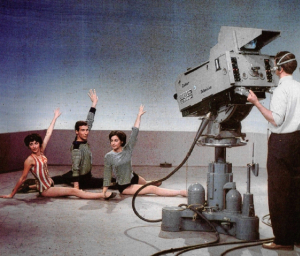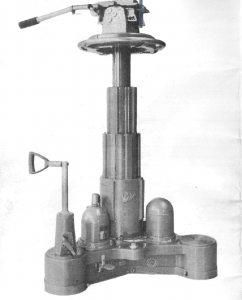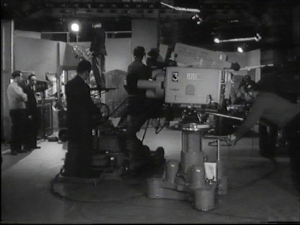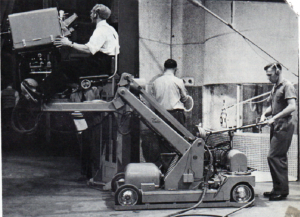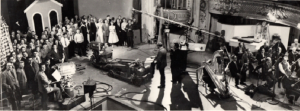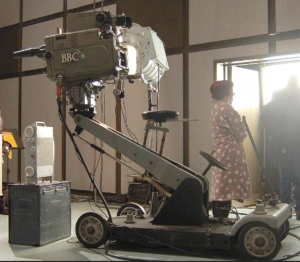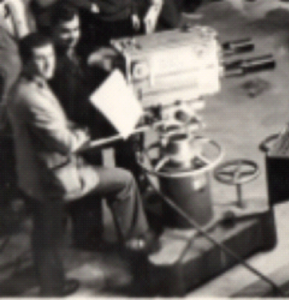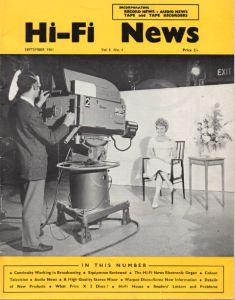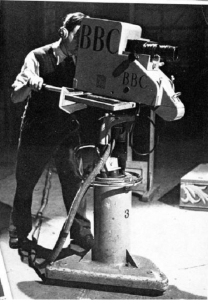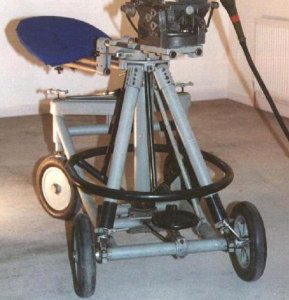Vinten Peds
Mike Minchin
The Vinten Tiller Ped, such as we used in the early 1960s, had a tiller and the small (non-rotating) ring.
Another copy of the same photo is in on Martin Kempton’s “History of Television Studios” (in the section on Colour Studios, naturally). (http://www.tvstudiohistory.co.uk/old%20bbc%20studios.htm#colour)
Doug Coldwell
I’m rather surprised that it could take the weight as I believe that the ram seals deformed at high such pressure.
Ian Ridley
You can always tell the Vinten tiller ped because the ring was smaller and fixed, of course, but the tiller itself never hung down – the spade handle part was always horizontal so you could grab it to turn it. As soon as ring steering came in the handle did not need to be accessible and was changed. In the curve between the wheels was a stirrup arrangement on two sides of the base with a wooden knob on each side. As you pushed the ped you could change direction in the middle of a track by putting you foot quickly in this, and turning it a bit. These were connected to the chain which went all the way round the base connecting the wheels and the tiller. I cut my teeth on these on camera 4 in studio D on the Sunday evening Dickens series we did in the early 1960s.
Dudley Darby
A picture from Vinten’s Operators Handbook.
Dave Plowman, Ian Ridley and Dudley Darby
The ring was brushed silver on the tiller ped, the height of the tiller was greater than the tiller on the ringsteer version. On the ringsteer version, too, the ring colour changed as it was coated in black plastic, perhaps to get a better grip The 419 had the longer tiller stem initially. It was later shortened when the large ring was added to allow us to reach the ring with a Marconi Mk VII aboard.
Bill Jenkin
I seem to remember being told not to use the tiller to steer the ringsteer peds in crab. I know this was widely ignored but am I remembering correctly?
Copy of image from tech-ops.co.uk
Vinten tiller ped with CPS Emitron camera. Vinten Motorised with tracker platform.
+++++++++++++++++++++
Vinten Motorised
The Vinten Motorised originally had tiller steering and an ambulatory dolly operator.
John Hays
As a new recruit to TV I remember driving a strange motorised mount on the stage of the theatre.It was like the one I used to push in H for schools progs, very heavy, but what was it ? You drove it by walking behind it and steering it by a tiller which had a speed control on it. It was too easy to get the thing out of control !
Maurice Fleisher
The crane with Mark Lewis on the front I am fairly sure was a tiller Vinten because I see no platform for the driver to stand on. This is a “Daily Mail” photo taken in King’s Theatre Hammersmith 1956. (I’m the one with his foot up on the pedestal, far left). Interestingly the article accompanying that picture was headed in large bold type “THIS IS WHAT WORRIES THE BBC” subheading “£2675 and hour for TV” (ed: quelle horreur!). They actually listed a total of 113 technical, production, orchestral and scenery crew plus unlisted people in the gallery. These days I think that figure might apply to the cost per minute. The one with Ted Langley is most certainly the beast you are referring to. As I recall, one had to be careful setting the dolly in motion because if you did it too quickly the motors would swing violently to one side and you could easily have the steering handle ripped from your hands. Yes, it was all fun in those days.
Mike Minchin
The ped is possibly an RCA something-or-other, and the camera in the centre is on a Vinten Motorised. I think that’s what you’re referring to when you talk of the motors swinging to one side.
Patrick Heigham
I do remember tracking a Vinten Motorised. If it was required to move off on shot, one had to engage the drive with one’s foot fiercely on the brake, and on cue, gently release. If the motor was engaged on shot, a most irritating lurch ensued. Early on, I was put to track the VM in TC2 on a schools programme. Starting far back in a corner, we had to track in on a curve and mate up with a tracking ladder in front of a series if sets, which we moved up and down on for the rest of the show. Having done it perfectly on rehearsal, I ballsed it up on transmission and ended up two feet further away from the set. No zooms to compensate for a frame adjust, and as it was Jim Atkinson up front, boy! did I get a mouthful! I then joined Sound!!
Alec Bray
In its later incarnation, the Vinten Motorised had a platform for the tracker and a steering wheel. Even in this form, the Vinten Motorised was a tricky crane to track, as the two rear wheels steered and were the drive wheels, as each had an electric motor mounted above it. As the wheels were turned to change direction, the speed of the wheels remained the same: the effect was that you seemed to get faster the tighter the turn. And the faster you seemed to go, the more difficult it was to correct! It was quite vicious.
Mike Minchin
Interestingly, a German, near academic site had a picture of a Vinten Motorised which was labelled as a Pathfinder. Wrong! But it did lead me to finding more about the Pathfinder. It originated as a film mounting called the Edmonton (I wonder why!) in imitation of an American original. It could be equipped with cable guards for use in TV studios, and I found a picture labelled Pathfinder which I think was actually an Edmonton with guards and a TV camera. The Pathfinder was a TV only replacement for the Edmonton.
I also found a pic which I’m fairly certain was taken in Riverside, and it had the Pathfinder which I used back in 1960 (and which maybe surfaced in “An Adventure in Space and Time” (2013)). This hypothetical Riverside picture also had a Vinten 419 (Ring Ped) with a Marconi MkIII on top (3″ or 4.5″?) along with a Dalek!
From the Golden Age TV site:
(http://www.golden-agetv.co.uk/equipment.php?TypeID=16)
“… The ‘Edmonton’ crane was based on the ca:1936 US Fearless ‘Panoram’ movie studio dolly. The distinctive Edmonton was built for the Rank Organisation and used mainly in British film studios. The crane had a central jib that could be raised 7ft and the turntable rotated 360 deg. The crane could be adapted, with the addition of cable guards, to operate in tv studios. Another version designed exclusively for television studios by Vinten was called the ‘Pathfinder’…”
++++++++++++++++++++++++++++
Houston Fearless and other dollies/peds
Ian Ridley
The ped in the picture is from the US and was called the “Houston”.
I joined in 1961 and was soon using it (the only one we had) on the “Tonight” programme with Cliff Michelmore in LG studio G. It was a pain – a small wheel with a crank handle on it is how you craned in up and down – not possible on shot. One evening on the closing music item with “Cy Grant” I missed putting the lock on that wheel after winding it up to full height, and ended up doing a slow to start with, but increasing speedy crane down, on a 9 degree lens on the CPS cameras of the time – in true BBC fashion I held the CU all the way down to the low angle shooting off the top of the set of course, until it all ended with a mighty thump! Nobody said a word !
Maurice Fleisher
The Houston pedestal was transported from AP down to LG (Studio H) with its equally heavy ‘coffin’ camera to continue the experimental colour service.
You will note the camera was given Hi-Fi status in one publication even though there were no microphones attached or was it the pedestal (also no visible mics) or was it the very young Judith Chalmers or possibly my hi-fi grunting at trying to manipulate the beasts. Hey, I had hair or was it a wig being held in position by the ‘cans? Of course that thing sticking out in front of the camera could have been a very large microphone but if memory serves it was a zoom lens 😉 There was a camera at one time that had a fourth black/white tube in addition to the three colour ones. It might have been this Marconi-copy RCA version. Can’t really remember too well. I still have one of those ‘BBC tv colour’ cards which you see stuck on the front but I opted out of keeping the attached camera due to lack of space in my ‘one up, one down’ at that time.
Ian Ridley
The ped in this picture is not the same ped as in the earlier picture – this ped, I believe, was electrically craned hence the wire leading to it. The other Houston I operated has a solid skirt and a larger steering wheel coming up from the base, and well as the smaller wheel with the crank on it for craning (which we can’t really see in the previous picture).
Peter Fox
Following up to Ian Ridley’s ident of the clunky geared column American pedestal, it was made by Houston Fearless, and was known to us by that name. Houston Fearless were (are) an analogue of Vinten, producing color processing equipment cinematic equipment and military stuff too. They have a long history, see this link:
http://www.hf76.com/about_us.asp
I remember (not very well) operating it very occasionally in Lime Grove and as Ian has implied its real purpose, along with the two Eclair peds was to demonstrate how lucky we were to have the Vinten Hydraulic Pedestal. I think I am right in believing that it lived on through the sixties in H, the colour studio, where it was ideal as it could cope with the excessive weight of the enormous RCA three image-orthicon tube colour cameras, by virtue of not having any hydraulics to fail! The easy-to-tip-over (done it, been there) geared French Eclair or maybe it was the even lighter Debrie, did last for longer in mainstream telly supporting an EMI Vidicon that provided caption overlays on Grandstand. (Superlock trolley?) There was an exciting moment once, switching off and derigging that Vidicon in E, when it it turned out that most of the BBC’s output was still genlocked to it. By the time I joined in October 1962 the Vinten Motorised all had stand-on platforms and steering wheels, I never saw its tiller controlled incarnation. There was a Pathfinder under the circle at TV theatre, never used. Allegedly Laurie Duley always wore a bow tie after inadvertently getting his standard necktie caught in the craning quadrant during a fast crane up. I can leave that to your imagination. It may be that Pathfinder that ended up in Weston Avenue, used by Visual Effects as a crane of the other sort, or a rather superior jack.
Graeme Wall
Both the EMI 2001 and the Marconi Mk7 had a fourth luminance tube.
Alan Stokes
Do I remember a Pathfinder in the Phoenix at Evesham in 1968? (TO29 9/9-13/12). With a not well supported floor, it made its own ‘dip’ and you were always pushing it uphill!
Roger Bunce
Re the Visual Effects stage at Western Avenue. I (dimly) remember using an ancient dolly they had there, but I don’t think it was a Pathfinder. It was a massive, heavy piece of ironmongery, which would have sunk into the mud if it had ever been allowed out on location. I think someone suggested it might have been an ‘Iron Man’.
John Howell
Here is an Iron Man at AP in 1950.
Peter Fox
Roger’s VisFX device is a jibbed dolly though, similar to a Pathfinder and possibly the same. The Pathfinder certainly looked heavy but was probably the usual Vinten aluminium or mag-alloy castings. I wouldn’t want to carry one upstairs, though.
Pat Heigham
Unfortunately, I put my back out severely, helping a Thames film crew carry an Elemack dolly (used in the Film Industry) up a spiral staircase. Silly Pat! Took six months with a chiropractor to get my spine straight again! So subsequently, when the first assistant calls out “OK, chaps, everybody round!” I make myself scarce in the opposite direction. This usually only happened in the days of TV company film units (small crews) not in Features where there were grips around to do the muscle work.
Peter Fox
I know some people despised the Vinten Penguin, but it really scored on a quick move upstairs! Dismantled in a minute, folded if necessary and ready to go again in 5. And no bad backs! And with care it still does a very good job on the tracks.
Albert Barber
On “Grange Hill” one crew with grips took a Vinten Penguin upstairs on a bus. It had to have ropes to tether it when the bus started. Fantastic effort from the crew. Alas it was in the days when we had OBs.
Dick Hibberd
The ‘Moi Man’ was a static OB mounting, with just two ‘scaffold’ type tubes from base to an adaptor which bolted on the bottom of a Vinten head. No height adjustment, apart from different length tubes during the rig.


